9 Organic & Non-Toxic Play Mats For The Most Eco-Friendly Fun
As a new parent you’ll quickly discover the value of non-toxic play mats.
Aside from staging the cuuuuutest baby photos, they provide a clean and safe surface for feeling, discovering, and development.
Between tummy time, crawling, rolling, tumbling, and playing, little ones spend a lot of time on their mat, which is why they should be made using only the safest organic materials.
Everything we recommend to you on Sustainable Jungle is independently researched and we ask all brands to confirm their claims. To avoid waste, we test products on an as needed basis. This post contains affiliate links. If you buy something through our links, we may earn a small commission. Learn more about why we do this here.
Only The Best Non-Toxic Play Mats For Baby
Lorena Canals got the thumbs up from our very own toddler. The Path to Nature washable play mat was a hit, providing sensory experience through colors, contours, and textures. Did we mention it’s made of all-natural materials?
Toki Mats offers all the play-safe padding of foam mats without none of the harmful offgassing chemicals thanks to their use of certified non-toxic and natural latex foam.
Makemake Organics elegant organic cotton play mats won’t just feel nice for your newborn but they’ll look nice in any room of your house.
To learn more about how we discovered these organic baby products, crawl to the bottom of the article.
The Full List Of Organic Baby Play Mats
Organic Play Mats
Non-Toxic Play Mats
Best Organic Play Mats
1. Toki Mats
Toki Mats’ Non-Toxic Foam Play Mats
Price Range: $145—$295
The non-toxic foam play mats by Toki Mats are designed with a firm (yet comfortable) OEKO-TEX-certified natural dunlop latex foam or GOLS-certified organic latex filling to cushion little ones learning to get on their feet.
The flame retardant-free filling is anti-bacterial, self-ventilating, non-allergenic (except for latex allergies), and biodegradable.
They can easily be folded for traveling, and have several removable cover options, either made of 100% organic cotton, OEKO-TEX-certified water resistant bamboo, or vegan leather.
The latter is in the Everywhere mat covers, made with OEKO-TEX-certified, water-based microfiber polyurethane (PU) that is weather-resistant and easy to wipe clean (but not machine washable).
About Toki Mats
Toki Mats was born during naptime, inspired by a mother’s need for a safe, comfortable, and supportive platform for her and her newborn to spend time playing on the floor.
We have yet to hear back from Toki on where these mats are manufactured.
Also available on Amazon
2. Makemake Organics
Makemake Organics’ Organic Cotton Play Mats
Price Range: $99
Makemake Organics’ washable organic cotton play mats are available in three quilted, round, reversible styles.
They’re perfect for both tummy time and playtime, featuring a GOTS-certified organic cotton cover dyed with non-toxic dyes and polyfill filling that bears on OEKO-TEX certification.
The high-quality materials ensure long-lasting play and many hand-me-downs to any younger siblings to come.
If it can’t be handed down, the cover (not the filling) is compostable.
About Makemake Organics
Florida-based Makemake Organics produces a range of organic, non-toxic products that all promise pure materials, minimalist designs, and quality.
They utilize fair trade Indian manufacturing, and rigorously test products at all stages to ensure they’re free of harmful chemicals.
3. Wee Gallery
Wee Gallery’s Organic Baby Play Mat
Price Range: $98
Wee Gallery offers reversible and packable organic play mats in adorable patterns like that of the Wildlife Reversible Playmat—or any other nature-inspired black-and-white prints.
Why black and white?
“High-contrast imagery offers the best opportunity for newborns to focus on visual stimuli and promotes visual exploration and engagement.”
Each one is made of non-chemically softened organic cotton voile paired with a machine-washable polyester filling that’s OEKO-TEX certified.
About Wee Gallery
Wee Gallery was founded with the goal of creating baby products that provide “effective visual stimuli and interactive experiences ideal for their development”.
This also includes wooden toys, soft books, learning cards, and other interactive activities for children of all ages.
These organic mats come from a GOTS-certified Indian factory that provides fair wages.
Wee Gallery uses FSC-certified paper and soy inks for anything printed, and are looking for an alternative to their any plastic packaging they use.
A portion of profits goes to One Tree Planted, specifically planting fruit trees in India to support communities with future livelihood opportunities.
4. Lorena Canals
Lorena Canals’ Non-Toxic Play Rugs
Price Range: $95–$395
We’re floored by Lorena Canals—so much so that some of their super soft washable rugs adorn our own home!
While this brand makes rugs for people and homes of all sizes, their collection of non-toxic nursery rugs is especially impressive.
Choose between stuffed natural play mats and an adorable collection of interactive play rugs, like the washable Veggie Rug where kiddos can “tend” their own garden—it’s never too early to cultivate a love for growing things, after all!
For us though, the Path of Nature with its peaks and valleys and range of textures was the most exciting play rug. Our boy loves to explore the paths, trekking a variety of animals and cars and other toys through the landscape with his imagination. It’s provided a literal basis for many hours of engagement.
Everything is made using recycled cotton, cotton, and wool, all of which are colored with GOTS and OEKO-TEX certified safe dyes.
About Lorena Canals
Lorena Canals ensures fair trade practices in production, predominantly employing women artisans in India in ISO 9001, 14001, and 18001-certified facilities.
Aside from providing a safe space for your littles to discover the world, they support children far and wide through the Sakûla Project by building nurseries for underprivileged children, providing safe spaces, free meals, and education.
They also donate to an Indian public school where their factory is located.
75% of water in their efficient “cone-dyeing” and washing process is reused, as well as most textile scraps to create their RugCycled® collection.
5. Pillobebe
Pillobebe’s Organic Play Mat for Baby
Price Range: $179
The CorkiMat® is what sets Pillobebe apart.
This organic non-foam play mat is OEKO-TEX-certified and features a removable organic cotton cover (some of which is non-dyed) with an anti-slip bottom. The insert tiles are made with hypoallergenic layers of compressed polyester.
They also have an Organic Cotton Play Mat range that has a 100% organic cotton designer print cover and 100% organic cotton inner batting.
About Pillobebe
Pillobebe got their start when they needed a play mat for their son—but then learned about the cancer-causing formamide found in foam mats.
So they invented an eco-friendly alternative, along with a blanket and several burping cloths.
Everything is handmade in the USA and tested by independent labs to confirm they’re free of formamide, formaldehyde, flame retardants, PU, PVC, BPA, BPS, phthalates, lead, latex, and VOCs.
6. Finch & Folk
Finch & Folk’s Non-Toxic Play Mats Australia
Price Range: $60–$120
For the cutest organic baby play mats in gender-neutral and brain-stimulating designs, flit on over to Finch & Folk.
Start their love of travel young with the Organic World Explorer play mat.
Regardless, a GOTS-certified organic cotton top is combined with an OEKO-TEX-certified polyester inner layer.
For budding artists, some feature a reusable coloring cloth that can be decorated and doodled on, washed, re-colored, and hung on the wall.
About Finch & Folk
Hailing from Australia, Finch & Folk offers some of our favorite blankets, soft books, and organic baby toys made with 100% organic cotton.
Everything is ethically made by a small family-run business in India.
Non-Toxic Baby Play Mats
7. wander & roam
wander & roam’s Eco-Friendly Play Mat
Price Range: $99—$189
wander & roam—the most aptly named brand on this list, wouldn’t you agree?!
Behold the wander mat: a non-toxic, hypoallergenic, nonflammable, easy-to-clean, comfy mat for babies and beyond.
The non-toxic reversible foam mat features a single piece of biodegradable thermoplastic polyurethane (TPU) foam that’s been tested as exceeding all US and European toy standards.
Being free of latex, BPA, formamide, and PVC, TPU “does not harm the environment in production, use or disposal”. It’s often used in medical devices as a non-toxic alternative to PVC and EVA.
Their vegan leather line features a vegan leather top and flocked suede bottom, but they haven’t confirmed what this vegan leather is made from.
About wander & roam
Mama-founded wander & roam also started with a search for an easy-to-use play mat.
To prevent the waste of returned mats, you can shop their discounted open-box returns.
They have not responded to our queries regarding where these are made and any ethical precautions in place.
8. Pehr
Pehr’s Eco-Friendly Play Mat for Babies
Price Range: $128
Browsing the selection by Pehr is like a peer into what your non-toxic nursery could look like.
Their non-toxic baby playmats are made with 100% cozy quilted cotton, screen printed by hand into several designs using natural, AZO-free dyes.
They’re also washer and dryer friendly.
About Pehr
The woman-founded company prioritizes working with women.
They partner with groups like Care & Fair, Good Weave, and Good+ Foundation to support low-income parents or provide opportunities for women in developing nations.
They’re eliminating single-use packaging and adopting more sustainable manufacturing practices.
9. Wunderkids Mats
Wunderkids Mats‘ Eco-Friendly Play Mats
Price Range: $279—$369
Wunderkids Mats have optomized the eco-friendly play mat with a unique, absorbent structure, featuring nine layers of high-density polyethylene foam.
Take comfort in the mat’s impact-absorbing layer for babies who have just started toddling and noise-absorbing layer for toddlers who just won’t stop.
Each non-toxic foldable play mat comes with a reversible vegan polyurethane leather cover free from hazardous substances.
About Wunderkids Mats
Wunderkids Mats is an award-winning and highly-certified brand—by the FDA, ECO Label, LOHAS, SGS Testing, and KCR Testing—so you can rest easy knowing your baby’s playtime is as innocent as it should be.
The brand is based in South Korea, which is also where all raw materials are sourced and manufactured by hand in-house.
For every mat purchased, three trees are planted.
Also available on Amazon (Canada)
Did you know we Have a Newsletter?
We cover the latest in sustainable living, fashion, zero waste, beauty, travel, finance and more…
Why Non-Toxic & Organic Play Mats?
Got a little one who’s scooting around or a babe in need of a soft landing for tummy time?
Looking for the best eco-friendly play mat is time well spent.
Babies spend a lot of their own time on the ground, of course. As curious tiny humans, they also love to lick, suck, and bite nearly any—and every—thing in reach.
With an immature body and a still-developing system that would struggle to process and metabolize chemicals, many products—even those designed for babies—can become toxic as the baby breathes or ingests it.
So, are play mats toxic and why?
EVA Foam & Formamide
Are foam mats safe for babies? Are EVA foam mats toxic?
EVA, or ethylene-vinyl acetate, is commonly found in foam-based products. Think: sporting equipment, costumes, craft materials, and, yes, play mats.
But it’s associated with toxic off-gassing of a chemical called formamide, which has been linked to reproductive issues and cancer. This has resulted in play mat-related formamide bans in some European countries.
While recent conflicting research sometimes suggests the safety of EVA, it’s also not recyclable or biodegradable—giving it a thumbs-down from us.
PVC & Phthalates
PVC, or polyvinyl chloride, is found in play mats, balls, dolls, inflatable swimming pools, and more.
Unfortunately, as flexible and useful as this type of plastic is, it is the worst kind.
Releasing lead and phthalates, PVC has been linked to cancer, premature puberty, reproductive and developmental disorders, and more.
It’s also responsible for releasing cancer-causing dioxins and emits 160 toxic gasses when disposed of.
Flame Retardants
Flame retardants are often from a class called polybrominated diphenyl ethers, which have been linked to negative health effects for children, including early puberty and delayed development.
Polyurethane and potential VOCs
The jury’s still out about polyurethane (PU) play mats. Although considered to be non-toxic, the material is flammable, meaning it may be treated with those pesky flame retardants.
In a study looking at PU foam mattresses, a significant release of volatile organic compounds (VOCs) was reported.
Still, polyurethane is fully recyclable and considered to be one of the least dangerous materials in baby products. Just avoid those treated with flame retardants.
XPE Foam
XPE foam is often marketed as “non-toxic” material, but it’s thin and lacks the softness found in TPU.
It’s also made of cross-linked polyethylene (PE) foam, which presents a similar risk as PE itself (i.e. offgassing, leaching plastic additives).
How To Choose The Best Non-Toxic Play Mats
Whew, that’s a lot of chemical exposure to expect when you’re expecting!
Fortunately, playtime isn’t canceled.
In order to make the best organic play mat for babies, these brands have looked high and low for earth friendly materials and processed them in a way that’s better for people and our planet.
Materials:
What is the best material for a baby play mat?
The answer is (always) natural materials like organic cotton, hemp fabric, linen, or natural latex—which are processed with fewer chemicals, hypoallergenic, more breathable, but have a far better end-of-life bedtime story.
Among synthetic fabrics still used in the playpen, polyurethane foam is strong, long-lasting, and good at absorbing shocks for little ones learning to walk. However, it does present some risks if treated with harmful chemicals.
TPU (thermoplastic polyurethane) is also strong and durable, but unlike PU it does not off-gas VOCs, nor does it contain BPA, BPS, BPF, or harmful plasticizers.
No matter the material, we always look for “free of” claims, chemical testing, and sustainability certifications to ensure safe, non-toxic baby play mats.
- Certifications: OEKO-TEX, Fair Trade, Global Organic Textile Standard (GOTS), Global Organic Latex Standard (GOLS)
Supply chain & business practices:
The best non-toxic baby play mat brands will contribute to a world worth raising our kids in.
We prioritize brands utilizing ethical manufacturing, paying fair wages, and supporting disadvantaged populations.
Carbon commitments & green practices:
We were extra goo-goo-ga-ga over non-toxic and organic play mats from brands that also took extra steps to look after the environment.
This included using carbon-neutral shipping via carbon offset programs, plastic-free packaging (anyone else trying to raise a zero waste baby?!), and goals to keep improving their manufacturing practices.
Final Thoughts On Organic & Non-Toxic Play Mats
Nothing puts a pause on playtime like toxic materials.
Fortunately, as this list shows, the fun doesn’t have to end.
You can’t totally baby-proof your home, and make it safer (and supportive) by choosing consciously-made products like eco-friendly diapers, sustainable baby clothes and, of course, organic kids’ play mats.
But in all our baby fever, it’s important we don’t forget that toxins exist in many other conventional products—and if we keep talking about this issue, manufacturers will have no choice but to adapt and evolve.
Let’s keep the rolly polly momentum by sharing this article with some new or expectant moms and dads.
Pin these:
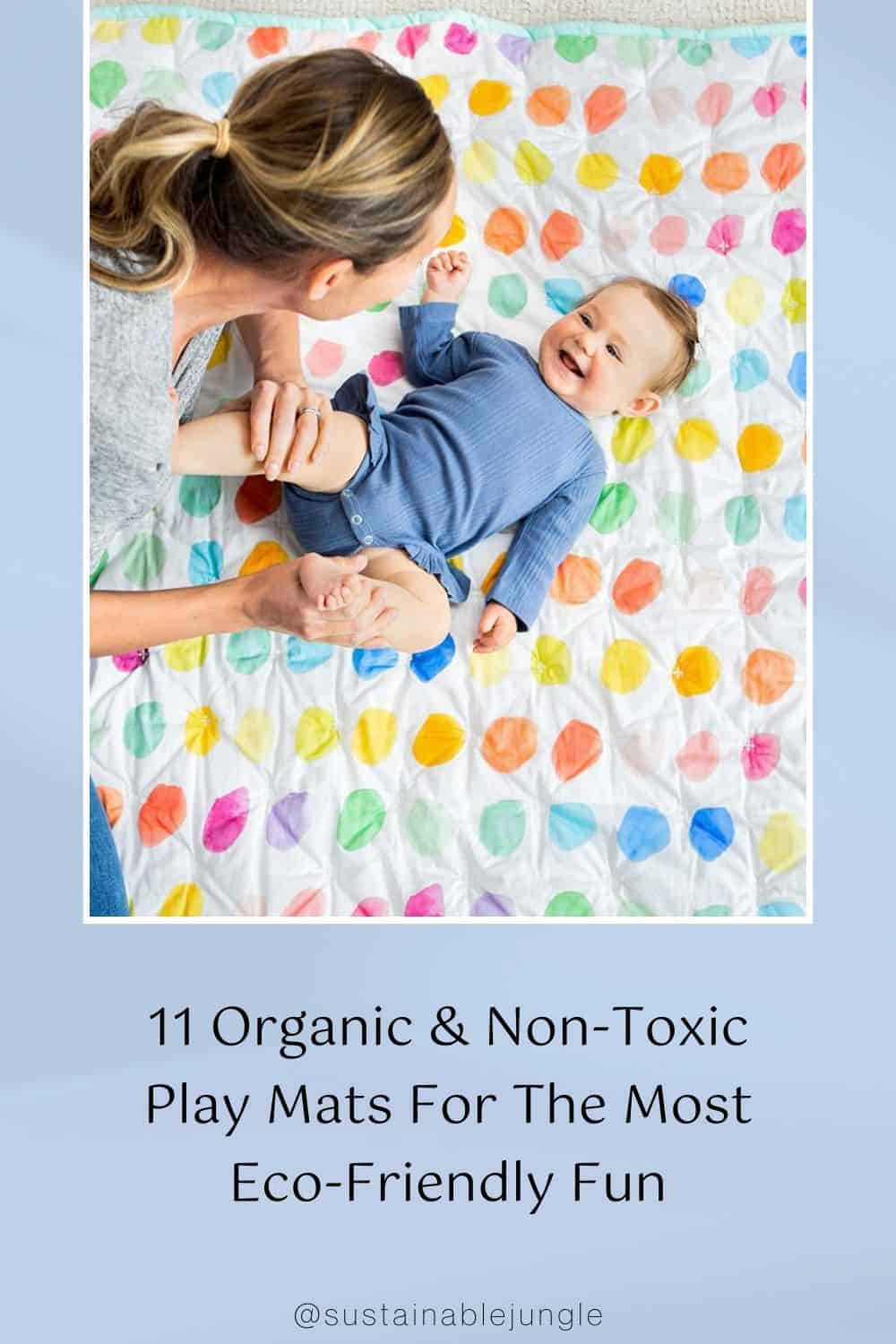
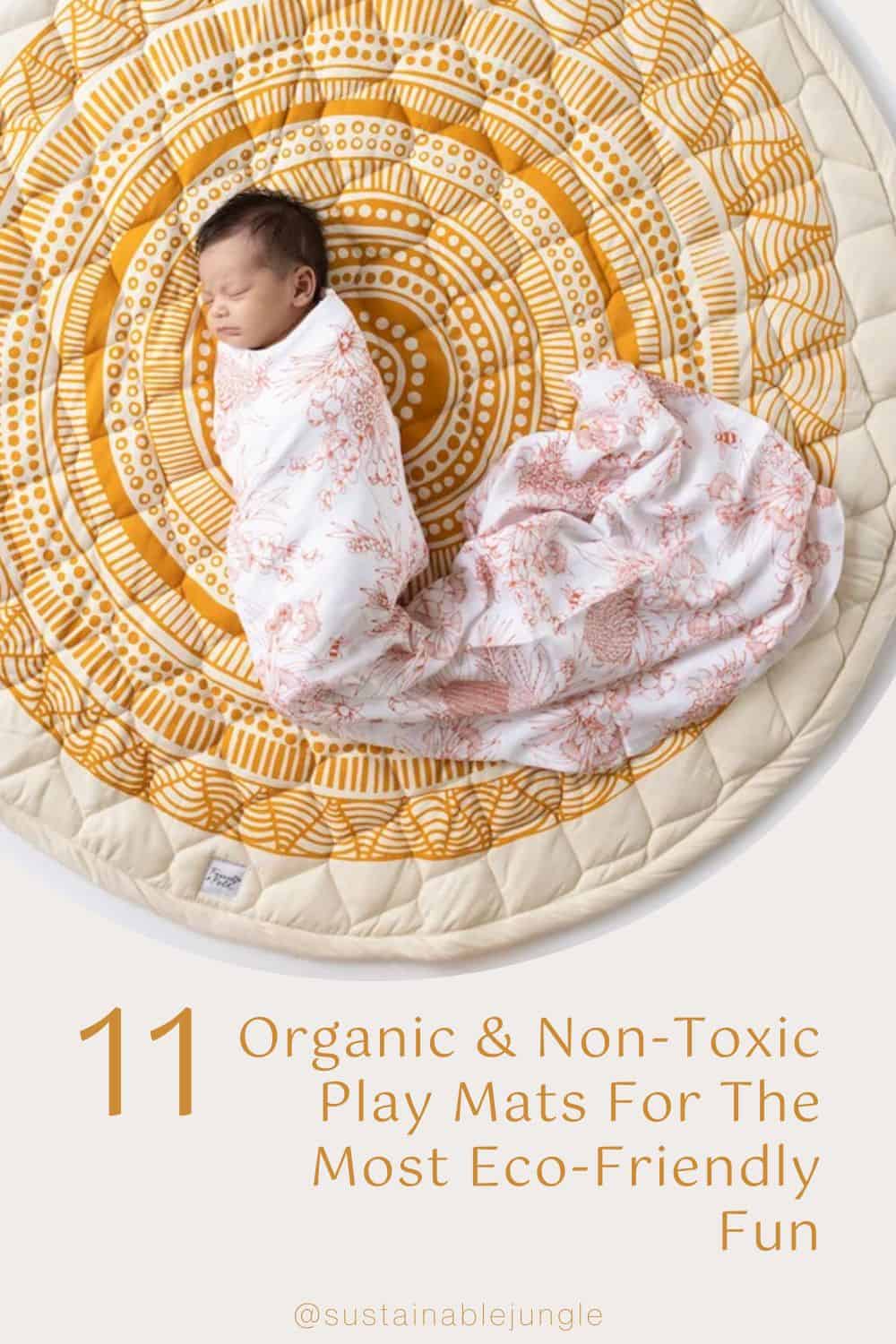


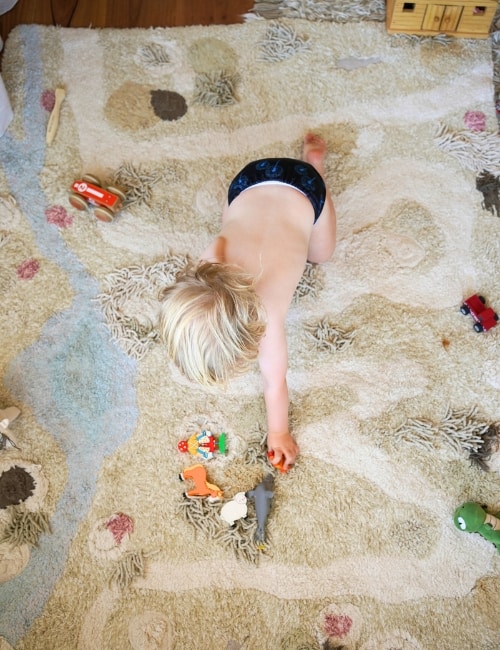
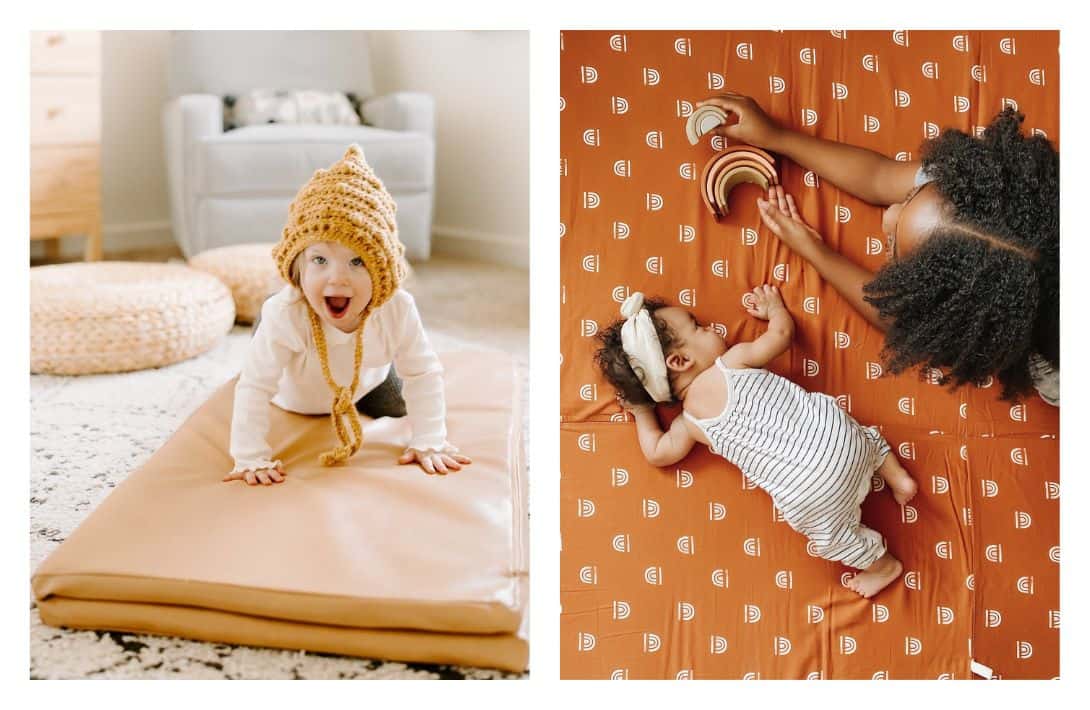
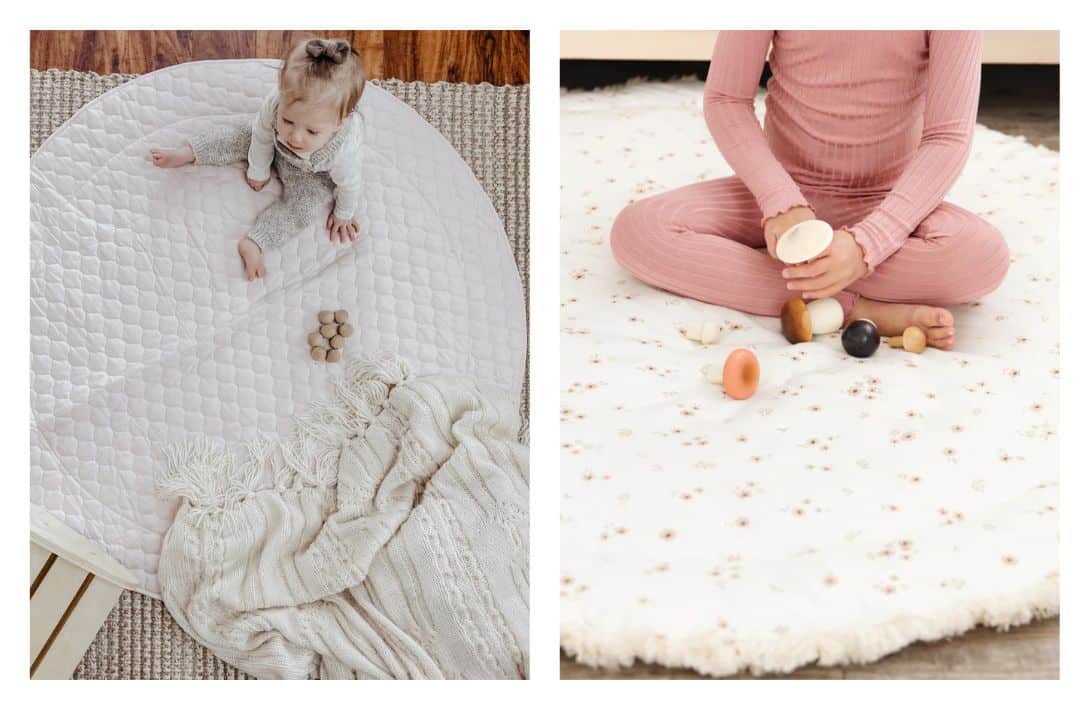
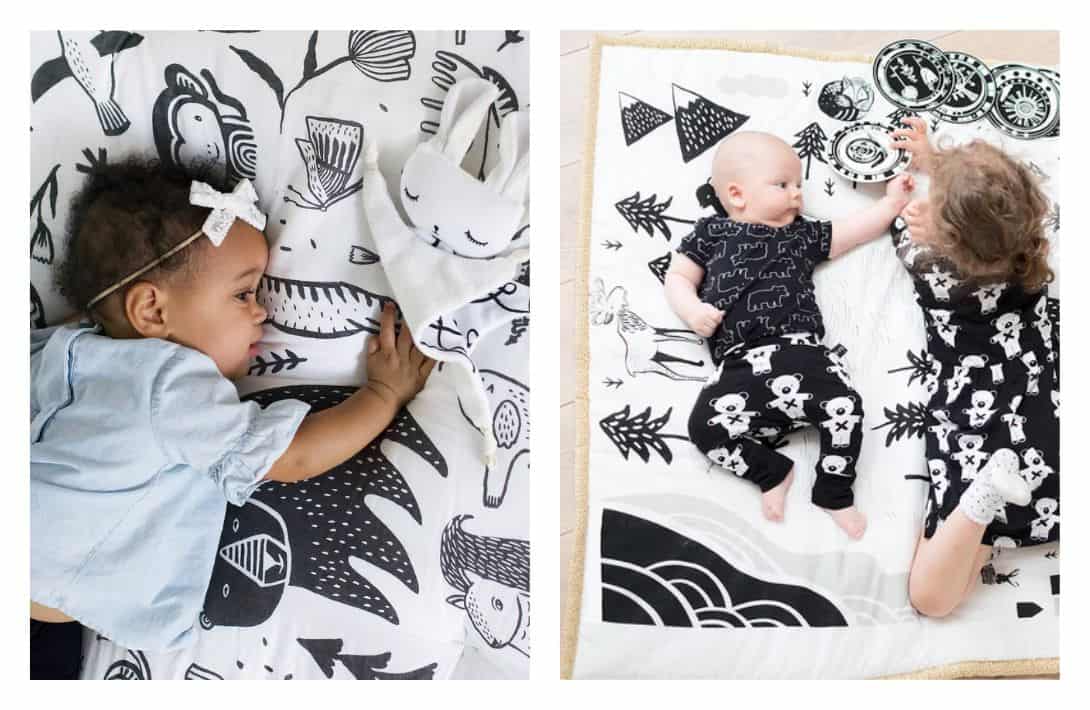
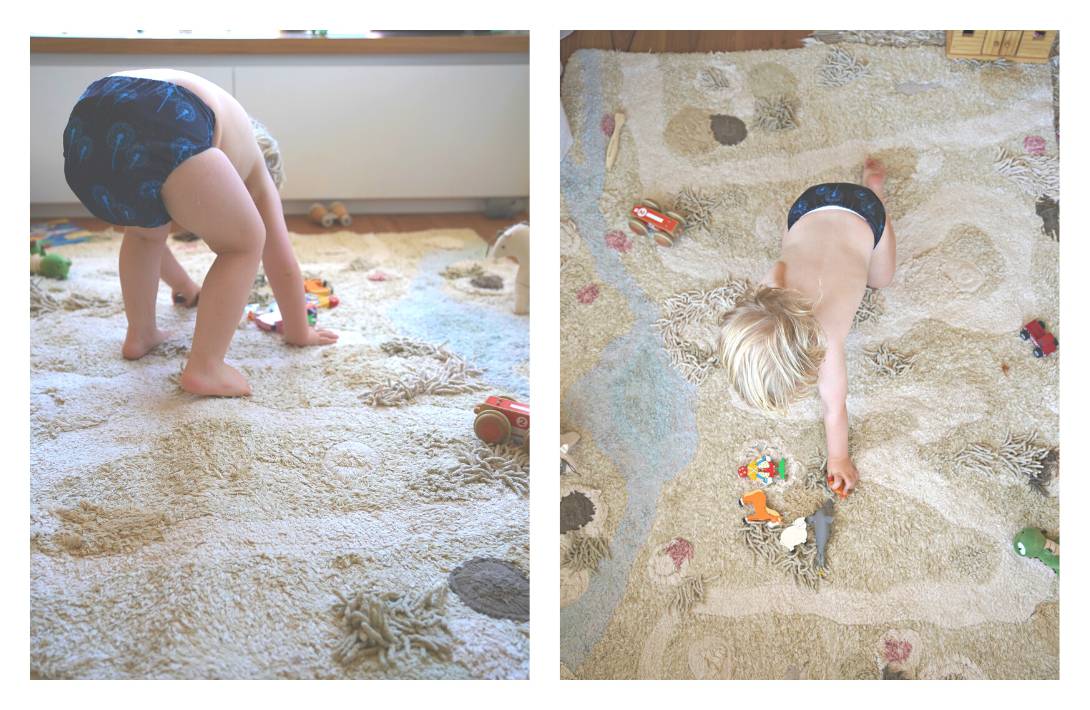
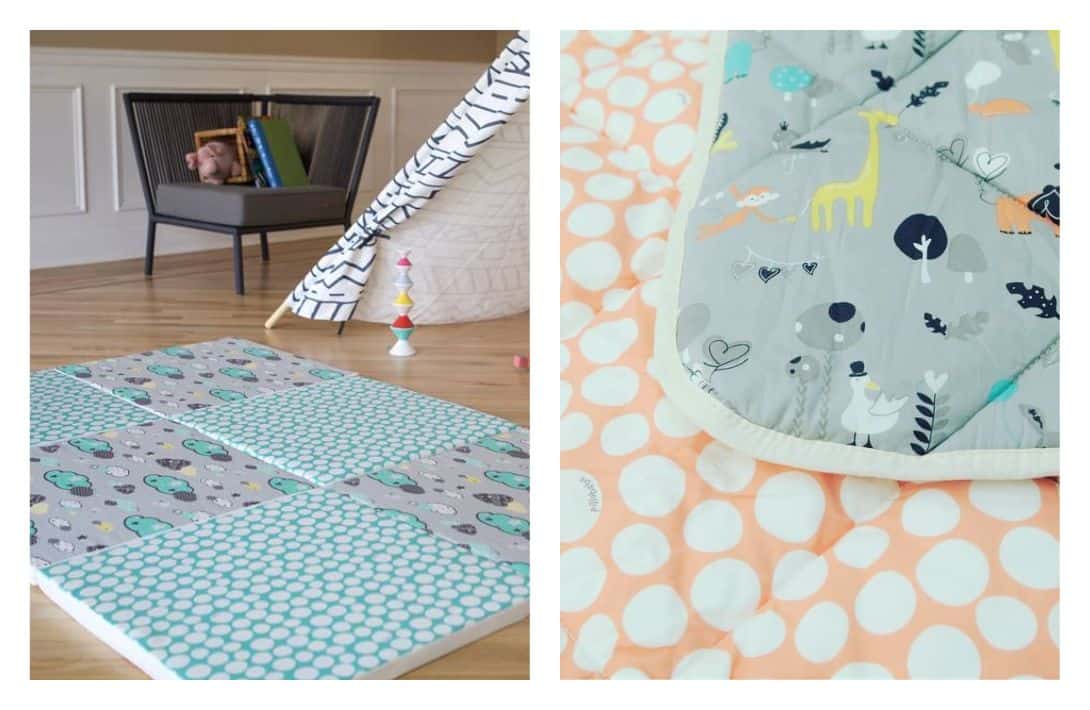
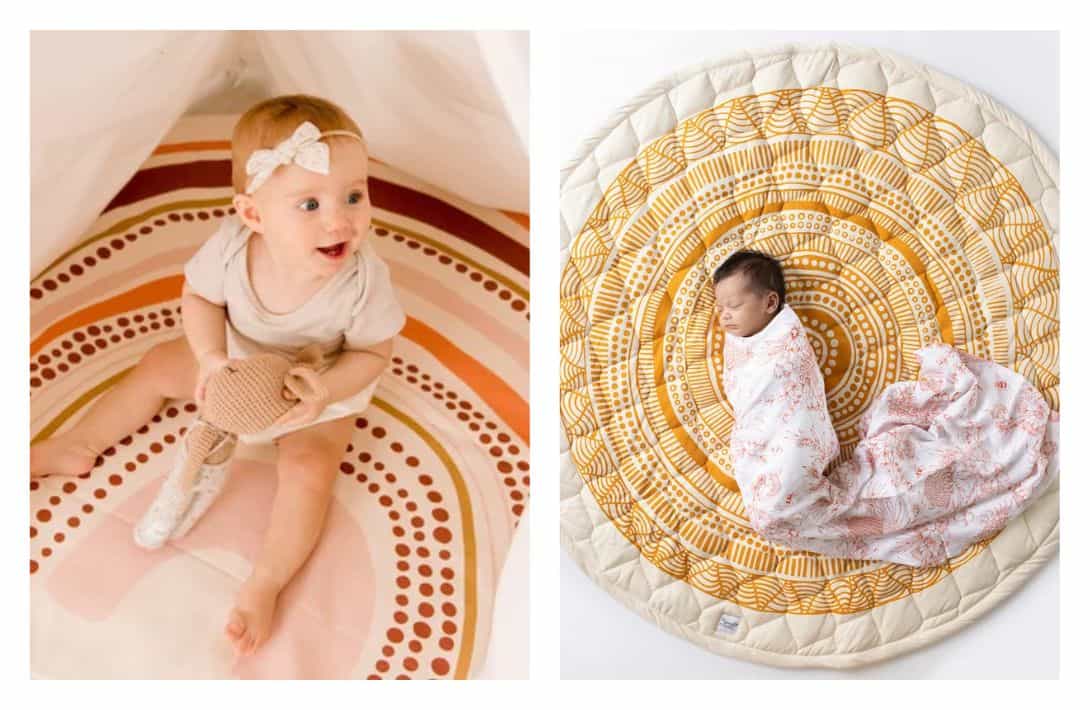
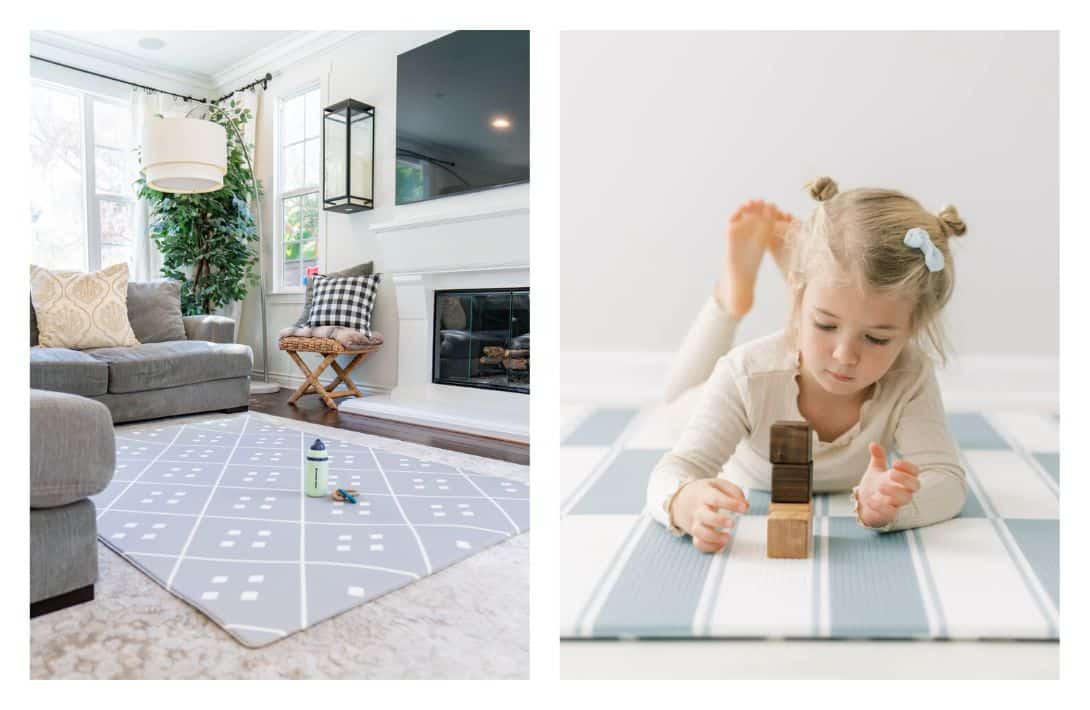
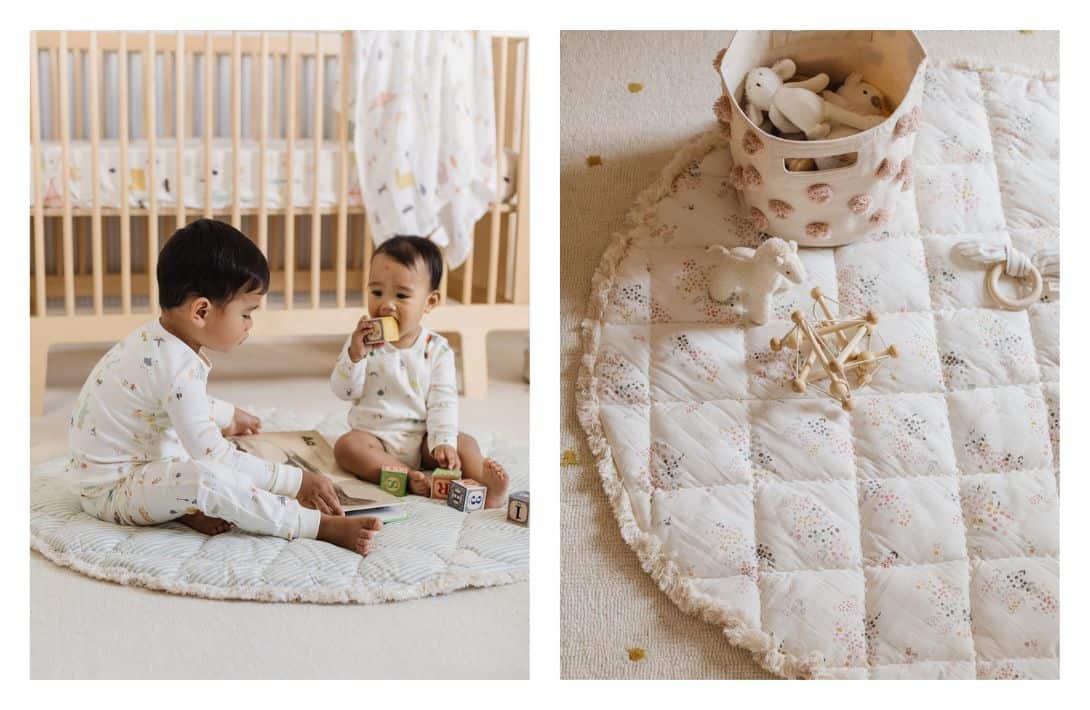

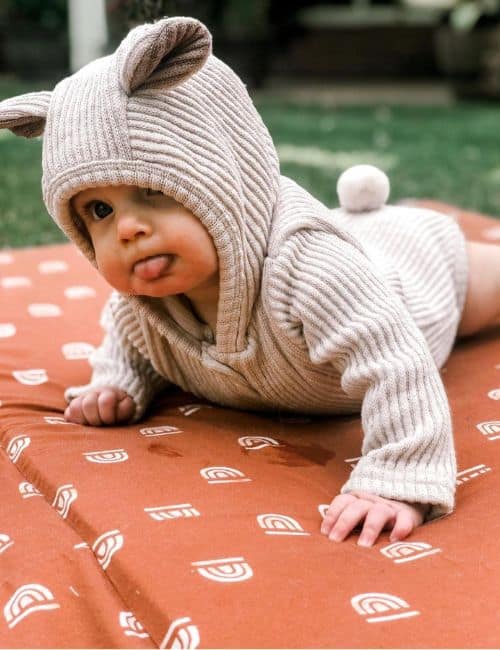
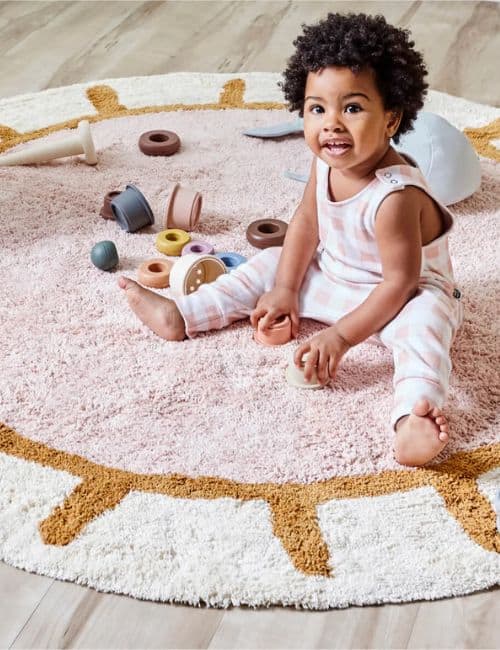
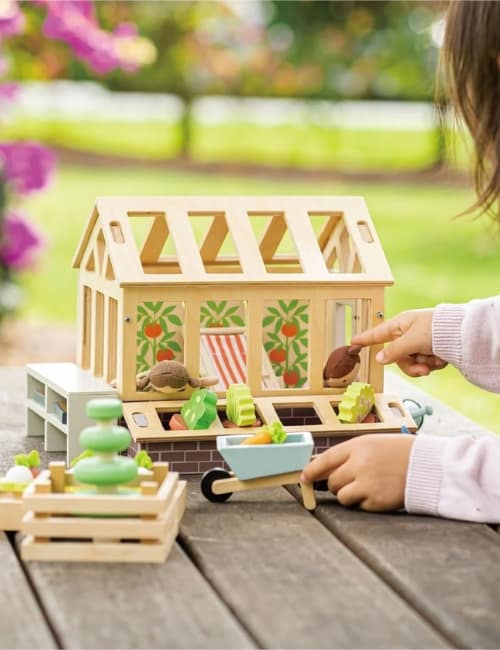
What are your thoughts on the mats by rugabub an Australian business that claim to be ecofriendly and nontoxic?
Hi Phoebe, I think I vaguely remember looking at these when I was looking for my bub (since we are personally in Australia too) but didn’t do a thorough deep dive. Just looking at the site now and if toxicity is what you’re most concerned about, I’d say they look good as they use TPU which is considered a safer material. I can’t see much on their sustainability policies (the ethics of their supply chain and so on) so not sure about that aspect.
What are your thoughts on Gathre mats?
Hi Tori, we’re about to update this article and took a look at the Gathre mats, they’re gorgeous but we didn’t quite make the top mats for this list because of the bonded leather material – we couldn’t easily find much about how this leather is sourced (we take a sustainability/ethics lens as well as a toxicity lens when we search for brands so this is important for us). Also leather is typically treated/tanned with a ton of chemicals so we couldn’t see any information on the tanning or treatment process. That’s not to say they don’t source ethically and treat their leather with a non-toxic tanning process, we just couldn’t find that information easily. So it might be worth reaching out to them for more information if you really love their mats. Hope that helps!
The lovevery mat is not organic cotton….
Hi Ashley, thank you for letting us know about this. I’m disappointed to see that you’re right and I have updated the post to make that clear. We will look for a replacement for Lovevery unless we receive further detail from them (we had reached out but yet to receive a reply). Thanks again!
I cannot wrap my head around how many of the mats recommended are filled with polyester fibres. Polyester fibres shed regularly are are some of the most pervasive, having been found everywhere and in everything from the depths of the ocean to human placenta and blood, and researchers increasingly concerned about impacts on human health. Certified or otherwise their properties remain the same, polyester sheds, attracts and transports other chemicals, and for something that a child spends so much time on their tummy on (inhaling microfiber particles) I cannot fathom why anything containing polyester is on the list?
Hi Laura, thank you for taking the time to comment. Fully agree polyester is less than ideal. We do struggle to find perfect products though and chose these 3 brands (at the time of the comment) for their organic/non toxic covers. Please do let us know if you find any incredible brands on your travels as we’re often updating these lists as we find more options with better sustainability credentials.